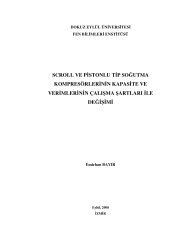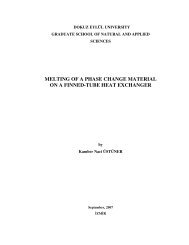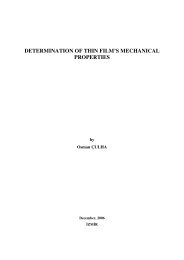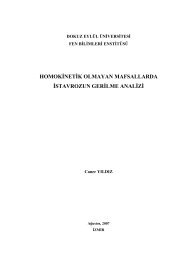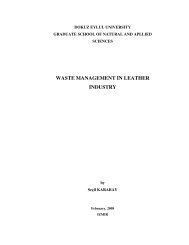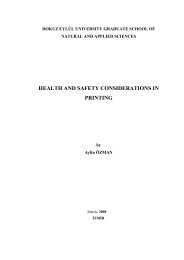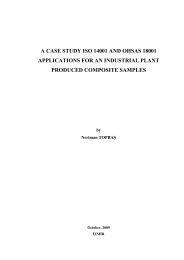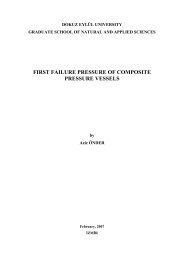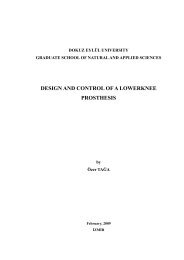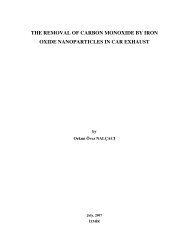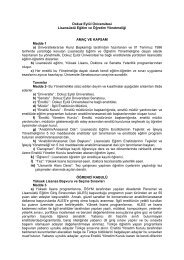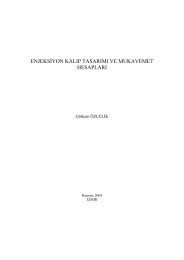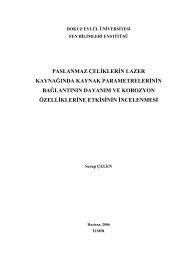ANSYS DESIGN OPTIMIZATION OF FOOT VALVE
ANSYS DESIGN OPTIMIZATION OF FOOT VALVE
ANSYS DESIGN OPTIMIZATION OF FOOT VALVE
You also want an ePaper? Increase the reach of your titles
YUMPU automatically turns print PDFs into web optimized ePapers that Google loves.
<strong>ANSYS</strong> <strong>DESIGN</strong> <strong>OPTIMIZATION</strong><br />
<strong>OF</strong><br />
<strong>FOOT</strong> <strong>VALVE</strong><br />
by<br />
Emre SİPAHİ<br />
July, 2004<br />
İZMİR
ABSTRACT<br />
In this study, 500mm diameter Foot Valve components, which are drafted by<br />
DOĞUŞ VANA VE DÖKÜM SANAYİ LTD. ŞTİ for mass production with casting,<br />
were optimized by using <strong>ANSYS</strong> program to obtain minimum weights.<br />
Volumes of two main parts of the foot valve were reduced to get minimum casting<br />
costs, which is a function of weight of the part to be produced. Relevant parametrical<br />
dimensions were obtained from manufacturers design criterias and international<br />
standards.<br />
Optimum dimensions and weights of foot valve components are evaluated by<br />
considering minimum casting costs and final component designs are completed.<br />
Valve components weights are reduced 6.36% due to optimization processes.<br />
ÖZET<br />
Bu çalışmada, DOĞUŞ VANA ve DÖKÜM SANAYİ LTD. ŞTİ. firması<br />
bünyesinde seri üretimi yapılmak üzere tasarlanan 500 mm. anma çaplı Dip<br />
Klepesinin, döküm tekniği ile üretilecek olan parçalarının minimum ağırlığa sahip<br />
olması için dizayn optimizasyonu, <strong>ANSYS</strong> programı kullanılarak yapılmıştır.<br />
Üretici firmanın döküm maliyetlerini minimuma düşürmek için, dip klepesinin iki<br />
ana döküm parçasının hacimleri, dolayısıyla ağırlıkları minimuma düşürülmüştür.<br />
Kullanılan parametrik ölçüler, üretici firmanın dizayn kriterleri ve ilgili uluslar arası<br />
standartlardan alınmıştır.<br />
Elde edilen optimum değerler doğrultusunda, dip klepesi parçalarının son ölçüleri<br />
ve nihai ağırlıkları minimum döküm maliyeti açısından değerlendirilmiş ve tasarım<br />
tamamlanmıştır. Optimizasyon işlemleri sonucunda parçalarda ortalama % 6.36<br />
ağırlıktan tasarruf sağlanmıştır.
1. Introduction<br />
In our contemporary world of competition, all companies should supply their<br />
goods and services with high quality in shortest period with lower prices than its<br />
competitors in order to keep their capacity and power to compete. Especially, in the<br />
manufacturing sector, beside to supply the goods in good quality, maximum discount<br />
in prices that companies can provide are being examined heedfully by the customers.<br />
Since it is a must in the business sector to try to obtain goods with high quality and<br />
best price in shortest time period, companies who have that capability will be chosen<br />
by the purchasers.<br />
From the beginning of the last century, the development in the techniques of mass<br />
production and incredible improvement in technology has become the most<br />
significant motive for the companies, which pursue a competitive and open policy.<br />
The companies involving with mass production pay great attention to the<br />
reliability of the product that is the product quality. Thanks to the ongoing<br />
developments in technology, the techniques of new product design has been<br />
improved and facilitated.<br />
The first design of a product that has been in the head of the engineers is<br />
illustrated in computers and then produced by computer-aided machines.<br />
The analysis and optimization processes of a product of which solid modeling<br />
have been accomplished can be carried out by ANYSYS and similar analysis<br />
programs in digital environment, before starting manufacturing. These processes give<br />
the companies flexibility in the development of a new product by providing design<br />
capability with minimum cost and minimum waste of time. ANYSYS program,<br />
which has been used in this study, can make the analysis and design optimization of<br />
the substances in many subjects including static, dynamic, thermal, harmonic and<br />
electromagnetic. Thus, this program can obtain necessary design requirements for a<br />
product in good quality with minimum cost.
Because the weight increases the cost of the product, in order to get a product with<br />
good quality and minimum cost, the weight of the materials should be revised.<br />
However, the companies try to keep their quality level stable when trying to lower<br />
the cost. In this regard, they apply a strict design optimization process in the process<br />
of new product development.<br />
It is widely known that in mass production even small fluctuations in input costs<br />
can affect the overall production costs and sales prices of the companies<br />
dramatically. If the companies have the lowest production costs then they can<br />
decrease their sales prices accordingly which led to an increase in their market share.<br />
In this study, using ANYSIS the static analysis and design optimization of foot<br />
valve with 500 mm nominal diameter and suitable for 16 bar working pressure which<br />
has been newly designed at research and development department of Doğuş Vana ve<br />
Döküm San. Tic. Ltd. Sti. By this optimization process, the thickness of foot valve’s<br />
parts, which are decided to be manufactured from ductile iron, has been minimized<br />
which has a decreasing effect in the volume and weight accordingly. Thus, while<br />
having the lowest cost of casting, the manufacturer will be assured by the quality and<br />
reliability of its product and add this item to its production range at earliest.<br />
2. What is Foot Valve?<br />
Foot valve, as shown in Figure 1, is a kind of valve that is placed at pump intake,<br />
provides water during the starting of pump operation by preventing back flow of<br />
water.<br />
In general, after pump starts operation, the sealing disc of foot valve opens<br />
because of pressure difference and allows water flow. Figure 2 shows the working<br />
principle of the foot valve.
2.1 Forces Acting on Foot Valve Components<br />
After the check valve in the pump line, even while the pump does not work, there<br />
is pressure required in the line. Pump suction line and foot valve are under system<br />
pressure due to a small water leakage of check valve. So PN 16 Bar pressure is<br />
applied to foot valve at the system.<br />
Figure 1. Foot Valve<br />
Check valve Gate valve<br />
Pump suction line<br />
Pump<br />
Pressure line<br />
System<br />
Soil<br />
Water<br />
Level<br />
Foot valve<br />
Water Well<br />
Figure 2. Working Principle of Foot Valve<br />
For a foot valve that will work under these conditions, the manufacturer should<br />
test the foot valve 1.5 times as working pressure as a requirement of ISO 2508
standard. It has been used 25 bar pressure in the analysis and optimization processes,<br />
taking into consideration the maximum test pressure that will be applied after<br />
production.<br />
Figure 3 and Figure 4 show pressure forces on the disc and body parts of foot<br />
valve.<br />
25 bar = 2.5 mpa<br />
Figure 3. Pressure Force on the disc<br />
Sealing Face<br />
Klepe Kapatma<br />
(sızdırmazlık) Yüzeyi<br />
25 bar = 2.5 mpa 25 bar = 2.5 mpa<br />
Figure 4. Pressure Force on the Body<br />
2.2 Valve Material<br />
In this study, International Standards and formulations about Cast Iron Pipes are<br />
used in order to get minimum thickness of components by considering valve<br />
structure, required pressure of pipeline and manufacturer preferences. Valve material<br />
is determined as GGG40 Ductile Cast Iron.
2.3 Material Specifications<br />
ρ ( density) = 7.3 x 10 -6 kg/mm 3<br />
µ ( poisson ratio ) = 0.3<br />
E ( Young Modulus )<br />
= 165.000 MPa<br />
“ Construction σ yield = 125 MPa DIN 1663” (Anık, S., 1999, p.181)<br />
Safety coefficient of stress S safety = 1.2. So ;<br />
σ Safety = σ yield / S safety<br />
σ Safety = 125 / 1.2 = 104.16 ≈ 104 MPa<br />
is determined as upper limit for stress.<br />
2.4 Design Constrains<br />
Cast iron pipes can be studied as four main groups by considering their pressure<br />
strengths as shown at Table 1. However flanged pipes such as Foot Valve are studied<br />
in groups B and C.<br />
German Cast iron norm DIN2431 is related with DIN2531 to determine the<br />
formulation to calculate thickness of cast iron pipes as below;<br />
Group A thickness = 1.1 LA group thickness ( χ = 11 )<br />
Group B thickness = 1.2 LA group thickness ( χ = 12 )<br />
Group C thickness = 1.3 LA group thickness ( χ = 13 )<br />
( Okday, Ş., 1975 p.14 )
Table 1. Max. Pressure values to applied cast iron pipes ( kg / cm 2 )<br />
Pressure ( kg/cm 2 )<br />
Nominal<br />
Manufacture<br />
LA<br />
Diameter<br />
A GROUP B GROUP C GROUP<br />
Type<br />
GROUP<br />
( DN )<br />
Test Pipeline Test Pipeline Test Pipeline Test Pipeline<br />
50 ... 70 20 12,5 25 16 - -<br />
Centrifugal<br />
>70...600 20 10 25 12,5 30 16 N/A<br />
Casting Pipes<br />
>600 15 10 20 12,5 25 16<br />
Casting Pipes<br />
50 ... 70 20 12,5 - - - -<br />
>70...600 N/A 20 10 25 12,5 30 16<br />
>600<br />
15 10 20 12,5 25 16<br />
Thickness of cast iron pipes can be calculated by using χ coefficient and the<br />
formula given below:<br />
Thickness = ( χ / 12 ) x ( 7 + 0.02 DN ) mm. ( 2.1 )<br />
DN is nominal diameter of pipe or valve.<br />
Thickness tolerance can be determined by using formula ( 2.2 ) .<br />
Tolerance = - ( 1 + 0.05 x thickness ). ( 2.2 )<br />
For this study, minimum thickness limit is determined using the following<br />
calculations:<br />
Foot Valve can be studied in Group C;<br />
Test Pressure = 25 Bar<br />
Pipeline Pressure = 16 Bar<br />
DN = 500 mm.<br />
So χ is determined as 13.<br />
Appling Equation ( 2.1 ) to get thickness value,<br />
Thickness = ( 13 / 12 ) x ( 7 + 0.02 x 500 ) = 1.08 + ( 7 + 10 ) = 18.08 mm<br />
Tolerance = - ( 1 + 0.05 x 18.08 ) = -1.904 mm
Minimum thickness value for foot valve components is calculated as;<br />
Minimum Thickness = 18.08 – 1.904 = 16.176 mm.<br />
Due to the capability of sand casting process used for the manufacturing of the<br />
foot valve components, 16mm thickness value is used for the lower limit.<br />
Flange dimensions are complying with ISO 7005 / 2, face to face dimensions are<br />
determined by manufacturer for the following sizes of foot valve DN400 mm., DN<br />
500 mm. and DN 600mm. Inner shape of the body seen in Figure 5, so as to permit<br />
the pass of required water flow rate when the valve is fully open<br />
In order to obtain required flow rate, water volume that passes around the sealing<br />
disc, must be equal to valve inlet water volume. So we have to get diameters by<br />
considering the equality of these volumes. Diameters are shown in Figure 5.<br />
D = Ø700<br />
d1 = Ø490<br />
DN = Ø500<br />
Figure 5. Inner shape calculation<br />
By using inlet diameter and outer diameter of sealing disc (490 mm) inner shape<br />
diameter can be calculated as follows:<br />
( π x DN 2 ) / 4 = ( π x D 2 ) / 4 - ( π x d1 2 ) / 4<br />
DN 2 = D 2 - d1 2 D 2 = DN 2 + d1 2<br />
D 2 = 50 2 + 49 2 = 2500 + 2401 = 4901<br />
D = 70 cm. = 700 mm..
1<br />
For sealing disc, outer shape of disc is same with body sealing face. So it’s<br />
dimensions are constant. <strong>ANSYS</strong> axissymetric feature is used to optimize symmetric<br />
components. Except the six rib of sealing disc, sealing disc body is optimized with<br />
axissymetric feature. However, six rib weights are not negligible values for sealing<br />
disc weight. Consequently, ribs are optimized separately from sealing disc body.<br />
2.5 Design Parameters<br />
Inner shape, flange dimensions and face to face dimensions are considered as<br />
manufacturer constants. Other appropriate dimensions are optimized. Edge radius<br />
and thickness dimensions are optimized for reducing body weight by considering<br />
state variables maxstress. Edge radius and thickness are determined as parameters<br />
and optimized to reduce sealing disc weights. Height and width dimensions are<br />
appropriate parameters for rib optimization.<br />
Parametric dimensions are shown as drawings in Figures 6, 7 and 8. Also<br />
parameters that are used for optimization are shown in Table 2.<br />
s<br />
r2<br />
s<br />
Figure 6. Parametric dimensions of sealing disc<br />
R3<br />
R2<br />
R2<br />
R3<br />
s<br />
s<br />
s<br />
s<br />
s<br />
s<br />
R4<br />
R1<br />
R1<br />
R4<br />
Figure 7. Parametric dimensions of body
R10<br />
175<br />
135.5<br />
R20<br />
y = 25<br />
g = 16<br />
Figure 8. Parametric dimensions of rib<br />
Table 2. Parameters<br />
Body<br />
Parameter Value Lower Limit Upper Limit<br />
s 18 16 25<br />
r1 10 7 15<br />
r2 18 15 20<br />
r3 10 7 15<br />
r4 18 15 20<br />
Sealing Disc<br />
Parameter Value Lower Limit Upper Limit<br />
s 22 16 25<br />
r1 20 10 25<br />
r2 10 5 20<br />
Rib<br />
Parameter Value Lower Limit Upper Limit<br />
g 16 10 20<br />
y 25 20 30<br />
3. <strong>ANSYS</strong> Analysis and Optimizations<br />
<strong>ANSYS</strong> parametric model is drafted by using parameters that are determined at<br />
Section 2. Two kinds of finite elements, quadrilateral two dimensional Plane42 or<br />
Plane82 can be used for analyzing body and sealing disc. Both elements support<br />
axissymetric <strong>ANSYS</strong> analysis. Plane42 has 4 nodes, Plane82 has 8 nodes. In order to<br />
obtain accurate analyze results, analyzer must use as much as nodes or element<br />
number that he/she can. (Moaveni, S., 1999)
Consequently in this study Plane 82 with 8 nodes is used for axissymetric analyze<br />
processes of body and sealing disc. And 3D Solid 92 element wtih 10 nodes is used<br />
for analyze of rib.<br />
Meshed body, sealing disc and rib model are shown at Figure 9, 10 and 11.<br />
Figure 9. Meshed body model<br />
Figure 10. Meshed sealing disc model
Figure 11. Meshed rib model<br />
For body totally 745 pieces quadrilateral finite elements, 2560 pieces nodes, for<br />
sealing disc 148 pieces quadrilateral finite elements, 537 pieces nodes, for rib 4044<br />
pieces finite elements and 6772 pieces nodes are obtained during the meshing<br />
processes. 25 Bar = 2.5 Mpa pressure is applied on the parts. Figure 12, 13, 14 and<br />
15 shows results of solutions.<br />
Figure 12. Element stress on body before optimization
Figure 13. Symetry expansion view of stress on body before optimization<br />
Figure 14. Element stress on sealing disc before optimization<br />
Figure 15. Symetry expansion view of stress on sealing disc before optimization
Stresses, volumes and weights of body, sealing disc and rib are shown in Table 3.<br />
Table 3. Analysis results<br />
Volume<br />
Body Sealing Disc Rib<br />
26038741.8<br />
mm 3 5115262.9<br />
mm 3 61707.12 mm 3<br />
Weight 190.08 kg. 37.34 kg. 0.45 kg.<br />
Maxstress 47.3132 MPa 66.96 MPa 2.962 MPa<br />
3.1 Optimization<br />
Values that are shown in Table 2 and 3 are used as optimization variables for<br />
optimization processes.<br />
Parametric values shown in Table 2, are used as Design Variables of optimization<br />
processes. Maxstress values that are shown at Table 3, are used as State Variables of<br />
optimization processes and volume values that are shown at Table 3, are used as<br />
Objective Functions of optimization processes.<br />
Upper limit of Maxstress value is 104 Mpa and lower limit is 30 Mpa. Upper and<br />
lower limits of design variables are shown at Table 2. Tolerance of Objective<br />
Function is determined as 10000 mm 3 .<br />
The most accurate optimization method named First-Order Method is used at all<br />
optimization process in this study. For this method maximum iteration number is 10.<br />
Figure 16, 17, 18, 19 and Table 5 show the result of optimizations. Also final<br />
parameter results are shown in Table 6.
Figure 16. Element stress on body after optimization<br />
Figure 17. Element stress on sealing disc after optimization
Figure 18. Symetry expansion view of sealing disc stress after optimization<br />
Figure 19. Element stress on rib after optimization<br />
Table 4. Optimization results<br />
Volume<br />
Body Sealing Disc Rib<br />
24773357.2<br />
mm 3 4500072.82<br />
mm 3 41552 mm 3<br />
Weight 180.845 kg. 32.85 kg. 0.3 kg.<br />
Maxstress 51.705 MPa 101.64 MPa 30.128 MPa
Table 5. Optimized parameter value<br />
Body<br />
Parameter Initial Value<br />
Optimized Design Value<br />
Value<br />
s 18 16 16<br />
r1 10 8.2078 8<br />
r2 18 15.783 16<br />
r3 10 7.840 8<br />
r4 18 17.101 17<br />
Sealing Disc<br />
Parameter Initial Value<br />
Optimized Design Value<br />
Value<br />
s 22 17.398 17.5<br />
r1 20 19.893 20<br />
r2 10 9.8823 10<br />
Rib<br />
Parameter Initial Value<br />
Optimized Design Value<br />
Value<br />
g 16 14.616 15<br />
y 25 20.789 20<br />
1/6 Symmetric model is drafted and analyzed by using dimensions that obtained<br />
from main disc body and rib optimization. There are the final Sealing Disc results as<br />
below;<br />
Table 6. Analysis results of Sealing Disc<br />
Body<br />
790241.9 mm 3 x 6 = 474145.14<br />
Volume<br />
mm 3<br />
Weight<br />
34.612 kg.<br />
Maxstress<br />
90.901 MPa
Figure 20. Element stress on 1/6 sealing disc model<br />
Maximum stress is gathered at intersection region of ribs and main disc body.<br />
Stress on disc that is drafted without radius, exceeded the safe stress value. Casting<br />
part has radius at this region. So this 5 mm radius reduces stress values to 90.901<br />
MPa as seen at Figure 20.<br />
4. Results and Discussion<br />
In this study design optimization of main parts of a foot valve, sealing disc and<br />
body, is carried out using <strong>ANSYS</strong>® package. The aim of the study was to minimize<br />
the weight of these components, which are manufactured by sand casting.<br />
Results obtained from optimization process are as follows:<br />
• Weight of Sealing Disc is reduced 13.5%.<br />
Initial total weight of Sealing Disc = 40.0 kg.<br />
Optimized weight of Sealing Disc = 34.6 kg.<br />
• Weight of the valve Body is reduced 4.85 %.<br />
Initial total weight of Sealing Disc = 190.08 kg.<br />
Optimized weight of Sealing Disc = 180.845 kg.<br />
• Total Weight of the valve is reduced 6.36 %.<br />
Initial total weight of the valve = 230.08 kg.<br />
Optimized total weight of the valve = 215.445 kg.
In this study, Sealing Disc was optimized at two steps. Disc body and ribs were<br />
optimized separately and then Sealing Disc Body was designed by drafting radius.<br />
In the optimization of valve body, the lower limit of thickness was obtained<br />
without reaching the safe stress value. Therefore, the optimization process provided<br />
the minimum body weight.<br />
More accurate optimization results could be obtained by using computers with<br />
higher capacity.<br />
Weight reduction obtained by the optimization process decreases the casting cost<br />
of the valve. 6.36% weight reduction might be useful to get discount of selling prices<br />
of the valve. As a result of this study, manufacturer has a big chance to sell its<br />
product in competitive market of the world.<br />
References<br />
Anık, S., Dikicioğlu, A. & Vural, M. ( 1999 ). İmal Usulleri<br />
Istanbul : Birsen Yayınevi<br />
Moaveni, S., ( 1999 ). Finite Element Analysis<br />
New Jersey : Prentice Hall Inc.<br />
Okday, Ş., ( 1975 ). Makine Elemanları, Boru ve Kapama Armatürleri ( 5 th ed. )<br />
Istanbul : Matbaa Teknisyenleri Basımevi<br />
Yıldırım, A., ( 2002 ).<br />
Yıldırım, A., ( 2003 ).<br />
Yıldırım, A., ( 2004 ).



